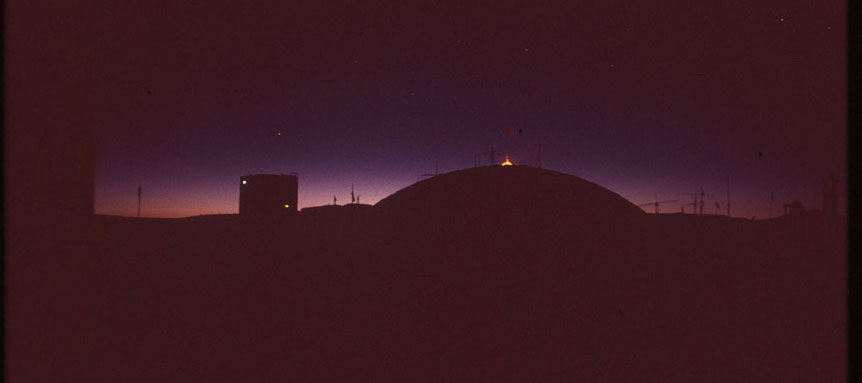
It is hard to believe that twilight is already reappearing. I am sad to see the beauty of the darkness disappear, but the next 3 weeks will be spectacular as sunrise gets closer. twilight at -100 degrees F August and September are usually the coldest months and we are seeing temperatures of -100 F (-73 C). the watcher just before the temperature dropped to -106.8 F in early August This is the time of the year when some people start dreaming about having the dome surf side in Hawaii . Meanwhile, I was just interested in selecting a parka that had a hood that matched my hair color . As it gets lighter and lighter out, we will be starting the station tasking necessary to prepare the station for opening and the first flight in late October. We have to return everything to pre-winter locations, re-install the radar reflecting skiway flags ( about two miles in each direction), get the aircraft skiway dragged and smooth, install the fueling hoses and pumps, dig out building and doorways that have drifted as much as 10 feet high, and many more tasks. In addition, my regular science work load will increase as reports, updated operating procedures and preparation for my replacement begins. One recurring task is digging out the cusp back door which has slowly dropped to about 30 feet below the surface of the Antarctic plateau over the past 26 years. This last blow really socked it in and I'm now digging. door drift from inside door drift from outside you can barely see the top of the door under the fire escape, second floor
My projects have been running reasonably well with one or two hardware of software failures per week that I must deal with along with the regular daily tasks. I assembled a few photographs of the project hardware that I am responsible for, from inside the laboratories and outside where the sensors are. The outdoor photos were taken last summer in bright sunshine. Locations were measured with a handheld GPS unit in November , 2000 and are in (degrees-minutes). The ice moves towards grid northwest almost 10 meters per year. The outdoor photographs were taken last summer when the sun was up. For more information on the science at Pole, see the Introduction page of this web site.
Cusp Lab: First Floor of skylab skylab me standing in front of electronics
racks 1 through 6 racks desk, computer and yellow brains
racks 1 and 2:
low frequency magnetometer (Lucent/Bell Labs)
magnetometer vault, dome in the
background (89-59.757' S, 100-14' E)
high frequency magnetometer (University of New Hampshire)
micropulsation magnetometer
vault buried under ice (89-59.757 S, 104-20.0' E)
phased imaging riometer data acquisition computer and display
(University of Maryland, UMD)
imaging riometer antenna (buried under
ice) and top of electronics vault (89-59.432' S, 111-40.0 E)
VLF/whistler radio Beta recorders, calibration electronics and receiver
(Stanford University)
VLF antenna about 3/4 mile from the
dome, more than half buried in ice (89-59.432 S, 98-05.0' E)
racks 3 and 4 :
VLF digital broadband computer and A/D electronics (Stanford)
VLF electronics and time code generator (Stanford)
broadbeam riometer data acquisition computer and display (UMD)
20.5 MHz antenna
30 MHz antenna
38.2 Mhz antenna
51.4 MHz antenna, buried
(89-59.483'S, 89-13.0'E) electronics vault
University of Maryland data acquisition interface
imaging riometer sensor electronics and heaters (UMD)
Racks 5 and 6:
UMD primary data collection computer
UMD/University of Delaware Cosray data interface
UMD broadbeam riometer sensor electronics and heaters
LF/MF/HF radio receiver data acquisition computer (Dartmouth College)
LF/MF/HF antenna (89-59.453' S,
94-27.3' E) ; station about 3/5 mile in the background
AstroMed 8 channel strip chart recorder (UMD)
UMD patch panel
Cosray Laboratory: Second Floor of Skylab
University of Delaware/Bartol Research
Institute Cosmic Ray/Neutron Detector data acquisition rack and computers
outdoor shielded boron trifluoride
detectors view to grid West
USGS/Global Positioning Satellite South
Pole Reference Station receivers and data acquisition computer
GPS antenna with dome removed on the
roof of skylab
Ultraviolet spectroradiometer and atmospheric nitric oxide detector:
Second Floor of the Atmospheric Research
Observatory
Ultraviolet spectroradiometer (Biospherical
Instruments, Inc)
UV radiometer installed in the penthouse
at ARO
Nitric oxide detector (Georgia Tech)
USGS Global Seismograph Station at South Pole, science building
Andrea, Aurora Science Technician, is responsible for the
U.S.G.S seismograph and many other
experiments.
She works in the skylab aurora laboratory, 4th floor, and at the radar
facility near the Marisat antenna facility
Andrea climbing down the seismic
vault last summer
She often enters the vault, 30 feet beneath the surface to perform
seismograph calibrations and repairs
(see the December web
page for more vault photos )
Many people are pulling out their cameras to take photographs outside
as the twilight gets brighter and brighter. Here are a few of the many taken
and developed by NSF science representative, Chris Martin.
heavily drifted garage arches
radio telescopes in the
dark sector
dome entrance
elevated dormitory
marisat satellite dish
flag lines
power plant and plume
new station at twilight
NEXT MONTH..............Sunrise